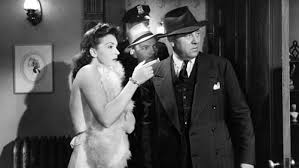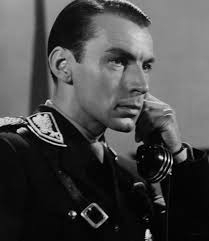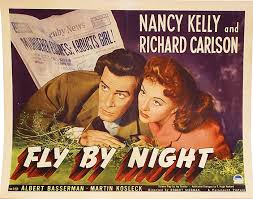Fly-by-Night (1942)
IMDb meta-data is 1 hour and 14 minutes, rated 6.8/10.0 by 148 cinematizens.
Genre: Mystery, Sy Fy
Verdict: Easy viewing.
The set-up: Everyman Richard Carlson stops for gasoline on a rainy night and when he gets back in the car, there is a drenched, bug-eyed Martin Kosleck (on whom more below) cowering in the back seat. Carlson is persuaded to give Bug-eyes a lift and a room at the first hotel they find in the storm.
The plot thickens when Bug-eyes is murdered in the room while Carlson is doing his nails or something. The plods arrive on cue and clamp him in irons, well they try to, but he escapes and takes the redoubtable Nancy Kelly hostage, sort of. It is all Stockholm Syndrome thereafter.
To clear himself with the law Carlson must crack the case by tracing the path of Bug-eyes back to the asylum from which he escaped. The nuthouse is full of nuts to be sure, and there are some Keystone Kops involved. Bug-eyes passed the word to Carlson before he croaked: ‘G 47!’ It is open sesame when he says that…. but the door slams shut behind him!
There is one very nice stunt when Carlson leaps from a speeding car onto an auto transporter and then later rolls a vehicle off the back of it at highway speed. Not sure I have seen that before, and certainly not in a film made in late 1941 without any CGI. Most of all there is Nancy the hostage who dominates the screen with her sass and feisty temper. Yet somehow they become unintentionally married! ‘Go girl,’ yelled the fraternity brothers!

The reference to patriotic panties got the attention of the bros, ever so briefly. A sales lady spruiks them with a V for Victory embroidered on the article and she refers to ‘fine silk for Uncle Sam.’ Stop! The silk would have been Japanese, and by 1939 many manufacturers had substituted rayon for Japanese silk because customers were boycotting Japanese products, and the rayon was cheaper and more readily available.
There is a nice plot twist at the end, which surprised this jaded viewer. That is what gets the Sy Fy tick above. The 19 January release implies production in November of 1941, leading to the conclusion that the nefarious Nazis were a late add to the script after Hitler declared war on the United States on 9 December 1941. (Why did he do that? I have always wondered. Send five box tops with the answer.)
Martin Kosleck (a Polish Jew refugee) made a Hollywood career playing Nazis, Göbbels alone five times.

Nancy Kelly (1921-1995) appeared on camera for the first time 1926 and for the last time in 1977. She was one of the few cute child actors to make the transition to maturity, albeit with a ten-year hiatus in the early 1930s. She gets top billing here in the credits, and rightly so. In addition to film, she also acted on radio and Broadway. Her good sense is evidenced in that she quit in 1977.
Siodmak directed, in this case not Kurt or Curt or Curtis, but Robert Siodmak, no relation to Kurt or Curt or Curtis.

Though how they co-existed in Hollywood in the 1940s and 1950s is a puzzle. I am sure the one was often confused for the other, but their biographies on IMDb make no reference to the other. Despite the name and the techniques of German Expressionism this Siodmak was from Memphis Tennessee, born and bred, albeit in German Town (been there). He did specialise in Noir and visited Germany to learn techniques in the 1930s. The highpoint of his career might have been the mysterious The Killers (1946).

